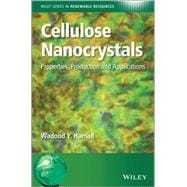
Note: Supplemental materials are not guaranteed with Rental or Used book purchases.
Purchase Benefits
What is included with this book?
Series Preface xiii
Foreword xv
Prologue xviii
1 New Frontiers for Material Development and the Challenge of Nanotechnology 1
1.1 Perspectives on Nanotechnology 1
1.2 Societal Ramifications of Nanotechnology 3
1.3 Bio]inspired Material Development: The Case for Cellulose Nanocrystals 5
1.4 A Glance at Bio]inspired Hierarchical Materials 9
1.5 Concluding Thoughts 13
Notes 13
2 Assembly and Structure in Native Cellulosic Fibers 16
2.1 Physical and Chemical Characteristics of the Cellulose Molecule 16
2.1.1 The Origin of Cellulose 16
2.1.2 The Chemistry of Cellulose 18
2.1.3 The Physics of Cellulose 20
2.2 Morphology and Structure of Native Cellulosic Fibers 22
2.3 Physical and Mechanical Properties of Native Cellulosic Fibers 25
2.3.1 Anisotropy of the Fiber Cell Wall 25
2.3.2 Mechanical Properties of Cellulosic Fibers 29
Notes 32
3 Hydrolytic Extraction of Cellulose Nanocrystals 33
3.1 Introduction 33
3.2 The Liberation of CNCs Using Acid Hydrolysis 35
3.3 Reaction Kinetics of CNC Extraction 38
3.3.1 Effects of H2SO4 Hydrolysis Conditions and Sulfation on CNC Yield of Extraction 38
3.3.2 H2SO4 Hydrolysis Reproducibility and Yield Optimization 46
3.3.3 Commentary on Hydrochloric Acid]Hydrolyzed CNCs 48
3.3.4 CNC Stability and Post H2SO4]Hydrolysis Aging 49
3.4 Processing Considerations for Sustainable and Economical Manufacture of CNCs 50
3.5 Micro/Nano Cellulosics Other Than CNCs 53
3.5.1 Microfibrillated Cellulose 53
3.5.2 Microcrystalline Cellulose 57
3.5.3 Bacterial Cellulose 60
Notes 62
4 Properties of Cellulose Nanocrystals 65
4.1 Morphological Characteristics of CNCs 65
4.2 Structural Organization of CNCs 68
4.3 Solid]State Characteristics of CNCs 74
4.3.1 X]Ray Diffractometric Analysis of CNCs 76
4.3.2 CNCs Phase Structure Based on SS]NMR 81
4.3.3 Concluding Remarks 87
4.4 CNCs Chiral Nematic Phase Properties 87
4.4.1 Ionic Strength Effect on Chiral Phase Separation 88
4.4.2 Temperature Effect on Chiral Phase Separation 91
4.4.3 Suspension Concentration Effect on Chiral Phase Separation 92
4.4.4 Magnetic Field Effect on Chiral Phase Separation 94
4.4.5 Sonication Effect on Physicochemical Properties 94
4.5 Shear Rheology of CNC Aqueous Suspensions 95
4.5.1 Basic Rheological Behavior of CNC Aqueous Suspensions 95
4.5.2 Sonication Effects on the Microstructure and Rheological Properties of CNCs Suspensions 98
4.5.3 Concentration Effects on the Microstructure and Rheological Properties of CNC Suspensions 100
4.5.4 Temperature Effects on the Microstructure and Rheological Properties of CNC Suspensions 106
4.5.5 CNCs Surface Charge Effects on the Microstructure and Rheological Properties of CNC Suspensions 112
4.5.6 Ionic Strength Effects on the Microstructure and Rheological Properties of CNC Suspensions 118
4.5.7 Aging and Yielding Characteristics of CNC Suspensions 123
4.5.8 Concluding Remarks 128
4.6 Thermal Stability of CNCs 129
Notes 134
5 Applications of Cellulose Nanocrystals 138
5.1 Prelude 138
5.2 The Reinforcing Potential of CNCs in Polymer Nanocomposites 140
5.2.1 Basic Concepts in Composites 140
5.2.2 Generic Methods for Surface Functionalization 142
5.2.3 Why CNCs for Reinforcement? 147
5.2.4 Performance of CNCs in Compatible Polymer Systems 150
5.2.5 Nanocomposites Prepared by Postpolymerization Compounding of CNCs and Thermoplastic Polymers 154
5.2.6 Controlling Nanocomposite Crystallinity and Plasticity via In Situ Polymerization Methodologies in the Presence of CNCs 165
5.2.7 CNCs in Thermosetting Polymers: Tailoring Cross]Linking Density and Toughness 172
5.2.8 Comments on Modeling the Mechanical Response of CNC]Reinforced Nanocomposites 177
5.2.9 Conclusions and Critical Insights 181
5.3 CNC]Stabilized Emulsions, Gels, and Hydrogels 184
5.3.1 Pickering Emulsions 184
5.3.2 High Internal Phase Emulsions 187
5.3.3 pH]Responsive Gels and Flocculants 189
5.3.4 Hydrogels 190
5.4 Controlled Self]Assembly of Functional Cellulosic Materials 194
5.4.1 Flexible CNC Films with Tunable Optical Properties 194
5.4.2 Mesoporous Photonic Cellulose Films 197
5.5 Toward Bio]inspired Photonic and Electronic Materials 202
5.5.1 Mesoporous Photonic Materials from Cellulose Nanomaterial Liquid Crystal Templates 202
5.5.2 Actuators and Sensors 217
5.5.3 Sustainable Electronics Based on CNCs 225
5.5.4 Conclusions and Outlook 232
5.6 CNCs in Biomedicine and Pharmaceuticals 233
5.7 Environmental, Health, and Safety Considerations of CNCs 235
5.8 Perspectives and Challenges 238
Notes 239
Epilogue—The Never]Ending Evolution of Scientific Insights 248
Bibliography 252
Subject Index 288
The New copy of this book will include any supplemental materials advertised. Please check the title of the book to determine if it should include any access cards, study guides, lab manuals, CDs, etc.
The Used, Rental and eBook copies of this book are not guaranteed to include any supplemental materials. Typically, only the book itself is included. This is true even if the title states it includes any access cards, study guides, lab manuals, CDs, etc.